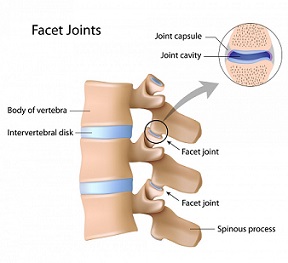A facet joint injection is a relatively simple, straightforward procedure, and is usually performed in an office based procedure suite or in an ambulatory surgical center.
As with many spinal injections, facet joint injections are best performed using fluoroscopy (live X-ray) for guidance to properly target and place the needle (and to help avoid nerve injury or other injury).
The Facet Injection
The injection procedure includes the following steps:
- Commonly, the procedure is performed without any sedation, however, an IV line can be started if relaxation medicine is needed.
- The patient lies on a procedure table, and the skin over the area to be tested is well cleansed.
- The physician treats a small area of skin with a numbing medicine (anesthetic), which may sting for a few seconds.
- The physician uses X-ray guidance (fluoroscopy) to direct a very small needle into the facet joint.
- A small amount of contrast dye is then injected to confirm that the needle is in the joint and that medication is contained inside the joint.
- Following this confirmation, a small mixture of anesthetic (such as lidocaine) and anti-inflammatory medication (steroid/cortisone) is then slowly injected into the joint.
The injection itself only takes a few minutes, but the entire procedure usually takes between fifteen and thirty minutes.
Immediately Following the Injection
- After the procedure, the patient typically remains resting in the recovery area for twenty to thirty minutes, and then is asked to perform some movements or activities that would usually provoke their pain.
- Patients may or may not obtain pain relief in the first few hours after the injection, depending upon whether or not the joints targeted are the main source of their pain. If the joint or joints being targeted are not causing their pain, a patient will not obtain immediate relief from injection.
- On occasion, patients may feel numb or have a slightly weak or odd feeling in their neck or back for a few hours after the injection.
- The patient will discuss with the doctor any immediate pain relief, and any questions or concerns.
The Day of the Injection
On the day of the injection, patients are typically advised as follows:
- Avoid doing any strenuous activities.
- Patients should limit pain medicine within the first four to six hours after the injection so that the diagnostic information obtained is accurate.
- Avoid driving, unless specifically approved by the treating physician.
- If sedation was used, the patient should not drive for 24 hours after the procedure.
The Week after the Facet Injection
Patients may notice a slight increase in pain lasting for several days as the numbing medicine wears off and before the cortisone starts to take effect.
In the week following the injection, common recommendations include:
- If the area is uncomfortable in the first two to three days after the injection, carefully applying ice or a cold pack to the general area of the injection site will typically provide pain relief.
- Patients may continue to take their regular pain medicine after the procedure.
- On the day after the procedure, patients may return to their regular activities.
- Patients may be referred for physical therapy or manual therapy after the injection while the numbing medicine is effective and/or over the next several weeks while the cortisone is working.
When the pain is improved, it is advisable to start regular exercise and activities in moderation. Even if the pain relief is significant, it is still important to increase activities gradually over one to two weeks to avoid recurrence of pain.
This content comes from: Source





